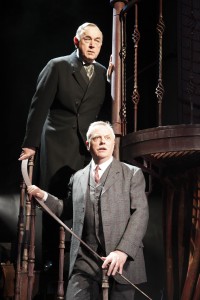The Secret of Sherlock Holmes
★★★☆☆ Elemental
King’s Theatre
By Thom Dibdin
It is not so much elementary as elemental at the King’s this week, as Jeremy Paul’s tribute to the great late-Victorian detective and his faithful friend and companion takes the stage under Robin Herford’s atmospheric direction.
While Philip Franks as Dr Watson and Peter Egan as Sherlock Holmes go about bringing their characters to creditable life, it is the back room creatives who give the play what bite it has.
Simon Higlett’s circular design, which suggests that a rooftop has been lifted up to look deep into the sitting room of 221B Baker Street, is an intriguing glimpse of a gentleman scientist’s layer. You can practically smell the wood and leather while the human skull, red-capped, and peering out from one wall seems hardly out of place.
But it is Matthew Eagland’s crepuscular lighting design with Matthew Bugg’s eerie sound and music, which impart most of the atmosphere. Shadows linger and build large across the back wall, while creaks and moans off indicate that another presence than the ones seen on stage is at large.
The elements of the Holmes/Watson relationship are faithfully created, too. Which is were Herford’s real directorial skill comes in, rather than the over-tricksy effects, as the play flits between dialogue and revelations or observations delivered directly to the audience.
It’s clever but lacks real substance. Those who have a modicum of knowledge of Arthur Conan Doyle, Sherlock Holmes and Dr Watson will be easily amused as it skips through the years of Holmes and Watson’s friendship, from their meeting in a chemistry lab to Watson’s marriage and Holmes encounter with his nemesis, Moriarty at the Reichenbach falls.
The references are not just present for their recognition factor, but to create a basis for the second act. Here, Jeremy Paul allows himself to go a little deeper into the mind of the detective as he questions the true nature of the relationships between Holmes, Watson and Moriarty.
There is something intriguing here, if a little over-egged. While Holmes and Watson pour out the recriminations about Holmes’ disappearance for three years, the explicit question is whether the villain even existed at all outside Holmes’ imagination. And if the drug-taking detective’s nemesis is thus created, why not, too, his biographer and companion?
Franks builds Watson as quite the gentleman: dapper, concerned and genuinely hurt at Holmes’ more heartless pronouncements. Egan’s Holmes is larger than life, deliberate in his assertions but somewhat lacking in his personal management skills.
Together, they sustain their end of the production with performances that are both broad enough to include any preconceptions that the audience might bring with them, and detailed enough to make the characters their own.
Egan is just a little too deliberate, however. His addition of a tiny pause between each line works well to start with, but once noticed you can’t help wondering whether it is there for effect or because he is bringing up the next line in his head.
A production which is big on atmosphere but which doesn’t match it in substance.
Run continues to Saturday, April 3
King’s Theatre website (with ticket booking details)
ENDS





















